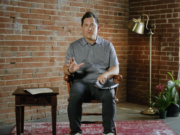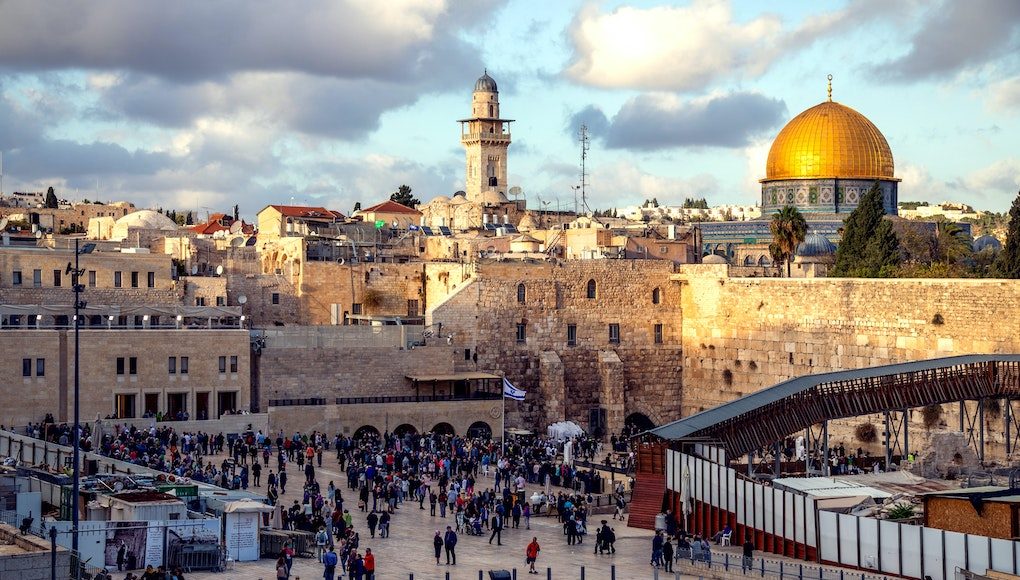First Impressions of The Holy City
Walls of honey-colored stones of varying in size and shape confine the narrow streets and alleys of the Old City. The vendors, rapidly wheeling merchandise on carts down these alleyways, nearly run over the tourists, many of whom are standing transfixed in the time warp into which they feel they have entered.
This is not what most people imagine the holy city would look like; the remains from Jesus’ day are usually several feet below the present street level. Many Christian pilgrims, oblivious of this fact, kneel and kiss the stones of the streets anyway – streets trod by Arab women from the villages who have brought their vegetables to market; orthodox Jews with their prayer shawls going to the Wall to pray; merchants, shoppers, soldiers, priests.
For many Christians, especially from the United States, the Church of the Holy Sepulchre is a particularly unexpected sight. How could this building possibly be the right place? The enormity of the building, the heavily ornamented shrines with their colorful candles and images, the fragmentation among the competing communities of faith, the disharmony of chants in different languages. So where is the hill of Calvary, the quiet tomb, the garden where Mary Magdalene brought spices for Jesus’ body? Why are the places associated with the death of the Lord not like we always imagined they would be?
We often expect the locations of the crucifixion and resurrection, events that changed the course of history and of our lives, to have been kept in their pristine condition, or at least to have been returned to their original appearance. What we can fail to appreciate is that we are witnessing the ways – sincere and with great devotion – that Christians of other cultures have expressed their worship of the Lord through the centuries.
Other changes have occurred as well. Since Jerusalem has continued to be inhabited, the city has undergone many changes over the centuries, just as any city would. Buildings have come and gone, the landscape of the area has been altered, the old has often been erased or buried. When we gaze down into the bottom of the excavations at the Pool of Bethesda, for example, we realize how much the topography of the city has changed, filling up valleys and pools with the debris that results from twenty centuries of human habitation.
People come here looking for the transcendent; they find the ordinary. Looking for solemnity, they find a hurried, working world. Looking for the eternal, they find the temporal. Yet in the person of Jesus, God’s holiness came into intimate contact with this ordinary, hurried, temporal place in a way that changed the world forever.
The Events in the Life of Jesus in Jerusalem
Several events of Jesus’ life happened here in this part of the city. In the western area, for example, was Herod’s palace, where the king received the Magi who were inquiring about the birth of the one born King of the Jews.
After this there was a feast of the Jews, and Jesus went up to Jerusalem.
Now there is in Jerusalem by the Sheep Gate a pool, in Aramaic called Bethesda, which has five roofed colonnades. – John 5:1-2
The first mention of Jesus visiting this area of the city is associated with a healing at the pools of Bethesda. The name, probably deriving from the Hebrew for “House of Mercy” (beth-hesedah), may indicate that there was a building by that name; in any event, the twin pools were also known as the Sheep Pool. Near this spot the paralytic was healed; one of the pools can be seen near St. Anne’s Church.
Although the specific location of the upper room, the location of the Last Supper, is not given in the gospels, it would also have been in this area of the city. Traditionally, the location of the upper room is in the Armenian Quarter. It was in the upper room that Jesus celebrated Passover and instituted the Lord’s Supper. Here also the apostles elected a replacement for Judas and received the Holy Spirit on the day of Pentecost (Acts 1:12-2:4).
After his condemnation by Pilate, Jesus was led out of the city to a hill called Calvary or Golgotha, where he was crucified. After his death, Jesus’ body was laid in a new tomb owned by Joseph of Arimathea, a tomb apparently near the place of crucifixion. Traditionally, the Church of the Holy Sepulchre has been identified as the location for both the crucifixion and the tomb.
The Archaeology of the Life of Jesus in Jerusalem
The Pools or Bethesda (the Sheep Pool)
Part of the area of the twin pools associated with the healing of the paralytic has been excavated in the yard of the Church of St. Anne. The pools can still be seen in the northwest and northeast corners of the excavation trench. A dam separating the two pools carried a street across to what may have been the “house of mercy” associated with healing. The columns of the Byzantine church may have been reused from the original colonnades mentioned in John 5:2. In AD 135 a pagan sanctuary was built over the area, which, oddly enough, confirms the location: small offerings found in the area identify the pagan structure as a healing sanctuary. Christians in the middle of the fifth century AD built their church over the remains of this sanctuary.
The Church of the Holy Sepulchre
Although the Church of the Holy Sepulchre is now within the city walls, it was outside the walls of Jesus’ day. Various places within the church contain remains from the first century, adding credibility to its identification as the location of Calvary and the empty tomb. Up the stairs you will see bedrock at a considerable height above the current floor; this is all that remains of the outcrop of rock, which is a probable location of Calvary.
In AD 135 Hadrian built a temple to the goddess Aphrodite directly over this outcrop of rock. In AD 326, when the pagan temple was razed, the workmen looked for the tomb of Christ. When they believed they had found the correct one, they dug out the bedrock around the tomb so that it now resembles a small chapel.
Next to a chapel claimed by the Armenians and the Syrians you will have access to several “kokhim”, deep horizontal niches used in first-century graves. This area can therefore at least be identified as a place where first century tombs were located outside the city walls, and this being a possibility for the correct location of Jesus’ tomb.
The Garden Tomb
The Garden Tomb is an alternate location for the death and burial of Jesus Christ however this location is highly contested. The Garden Tomb was discovered in 1883 by the British General Charles Gordon who believe that a stone outcropping reminded him of what he believed Calvary should look like as well as a tomb nearby. However this tomb dates several years before the 1st century AD and Jesus was said to have been buried in a new tomb according to Luke 23:53, “a tomb cut in stone, where no one had ever yet been laid.” Were it not for the New Testament statement that Joseph’s tomb was new, this would not make this site such a controversial possibility.
The Garden Tomb, located north of Damascus Gate, was suggested in the 19th century as an alternative site of Calvary and Jesus’ tomb. While the setting is very suggestive of what the garden would have looked like in the time of Jesus, excavations would seem to indicate that the tomb is too ancient to have been the one built by Joseph of Arimathea. The details of the chiseled walls and the bench type of arrangement suggest a date during the Old Testament.
Nonetheless, this is a very special place for more visiting believers today as they reflect on what it may have been like for Jesus to be crucified outside the city and then buried in a tomb near Jerusalem.
The Palace of Herod the Great
Herod’s palace was located in the area that is now called the Armenian Quarter of the Old City. The palace complex extended from David’s Citadel to the area of Christ Church, the Jaffa Gate police station, and the Armenian Garden. Traces of the palace foundations, columns, and cisterns have been found in those areas. The foundations of the large tower inside Jaffa Gate are probably those of the tower of Phasael, which was built in memory of Herod’s brother.
The Room of the Last Supper
The Cenacle, the traditional location of the upper room that Jesus borrowed in order to have Passover with his disciples, is in the area of the so-called “Tomb of David.” (More correctly, the tomb was probably the royal burial place of the later kings of Judah, rather than of David himself; David would have been buried in the ancient City of David.) In any event, the room of the Last Supper is also probably the same one in which Jesus appeared to his disciples after his resurrection, and where the Holy Spirit descended at Pentecost.
There is a possibility that this is indeed the correct location for the upper room. According to Epiphanius, a fourth century bishop who lived in Palestine for at least 20 years, several first century buildings had survived into the time of Hadrian (AD 135). Among these was the small Christian church. If the original Christian community continued to meet in the upper room, then it is likely that Epiphanius’ small church was at that location.
When this church was rebuilt on a larger scale in the late fourth century, it was called the Upper Church of the Apostles; a century later it was known as the Mother of Zion Church. A small apse in the “Tomb of David” is all that remains of this church, since it was burned during the Persian invasion in AD 614. Finally, a mosaic floor in Madaba, Jordan (about AD 600) includes a depiction of the church in just this area of Jerusalem.
The House of Caiaphas
The house of Caiaphas (who was the high priest during the trial of Jesus) is no doubt in the area of other luxurious homes on the Western Hill. The location has traditionally been identified with the Church of St. Peter in Gallicantu (St. Peter of the Cock Crow), but there is very little evidence to support this. It was once assumed that a unique set of weights found at the site was a special kind used only at the Temple, and which the high priest might have in his home. We now know, however, that there was considerable variety in the types of weights, so these were not necessarily unique to the Temple. A more likely identification of the house of Caiaphas is that of the Herodian Mansion.
So What Can We Learn from Jesus’ Time in Jerusalem?
A Temporary Death
A young Jewish man was showing his Christian friends from America around Jerusalem. Wishing to be helpful, he took them to the Church of the Holy Sepulchre. Then he heard that there was another place, called the Garden Tomb, which may be the correct location. Striving to not be negligent in his duty, he took them to the Garden Tomb as well.
While waiting for his friends there he exclaimed, “I don’t get it. The Catholics have Jesus buried over there. The Protestants seem to think he is buried here.”
A Christian overheard the remark and said, “Oh, he isn’t buried here either.”
Thinking there was yet another place, he turned in astonishment to hear more. “You mean he isn’t here?”
The stranger replied, “No! He is risen from the dead.”
We too must remember that the former occupant of the grave is more important than the grave itself. Jesus is no longer dead, but is alive and well and seated at the right-hand of the thrown of God. Remember this story:
But on the first day of the week, at early dawn, they went to the tomb, taking the spices they had prepared. And they found the stone rolled away from the tomb, but when they went in they did not find the body of the Lord Jesus. While they were perplexed about this, behold, two men stood by them in dazzling apparel. And as they were frightened and bowed their faces to the ground, the men said to them, “Why do you seek the living among the dead? He is not here, but has risen. Remember how he told you, while he was still in Galilee, that the Son of Man must be delivered into the hands of sinful men and be crucified and on the third day rise.” – Luke 24:1-7
With the exception of Peter and John (John 20:1-10), no one else seems to have visited the tomb after the resurrection. What was important was the fact that it was empty: for Jesus, the grave was only a temporary residence.
This tomb, however, played an important part in the gospel story. Jesus was buried in a particular kind of tomb, the knowledge of which helps us understand the prophecy of Isaiah:
He was assigned a grave with the wicked, and with the rich in his death,
though he had done no violence, nor was any deceit in his mouth. – Isaiah 53:9
Jesus’ burial in the tomb of a rich man, Joseph of Arimathea, was an aspect of what the Messiah would go through. Let us examine more closely the tomb of Jesus.
Then he took [Jesus’ body] down, wrapped it in linen cloth and placed it in a tomb cut in the rock, one in which no one had yet been laid. – Luke 23:50-53
A tomb in which no one had been laid: what other kind of tomb is there? Who would think of reusing a tomb? Since Old Testament times, people had been buried in family tombs. A cave would be hewn out of the rock, with ledges prepared to receive the wrapped body of the deceased.
When people died, they would quite literally be “gathered to their fathers”; a family tomb would serve quite well for hundreds of years. But since Joseph’s hometown was too far from Jerusalem to be buried before sunset on the day of his demise, he dug a new one close by.
But this was no ordinary tomb: it had a rolling stone. Most tombs were closed with a stone plug, but a rolling stone tomb was scaled with a large stone disk which rolled back and forth in a slot. Rolling stone tombs were so rare that the only examples we have belong to royalty. For example, when Queen Helene of Adiabene converted to Judaism, she came to Jerusalem to live. Her elaborate tomb complex (erroneously known as the Tomb of the Kings, north of Damascus Gate near the American Colony Hotel) is an excellent example of this kind of tomb. The family of Herod was also buried in a rolling stone tomb (behind the King David Hotel). What these tombs have in common, besides their construction, is the fact that they belonged to very wealthy people. Joseph must have been quite rich. By the very tomb described in the Gospels, we know that Jesus was associated with the rich in his death.
What is most important about the tomb, however, is that it was empty. His grave was temporary, just like his death. His accommodations, however, were first-class.
Because of the Resurrection our deaths arc temporary, too. There is no reason to fear death, no reason to dread the grave. The One who stepped from his new grave long ago will also call us from our temporary resting place:
in a moment, in the twinkling of an eye, at the last trumpet. For the trumpet will sound, and the dead will be raised imperishable, and we shall be changed. For this perishable body must put on the imperishable, and this mortal body must put on immortality. When the perishable puts on the imperishable, and the mortal puts on immortality, then shall come to pass the saying that is written:
“Death is swallowed up in victory.”
“O death, where is your victory?
O death, where is your sting?”
– 1 Corinthians 15:52-55
Love Israel-related content like this? Subscribe here to receive more content from Josh Weidmann and a free sample chapter of the book He Walked With Us: A Geographic Devotional Guide of the Land of Israel
Subscribe to Receive A Sample Chapter of "He Walked With Us"
This page will redirect to a download page as well as an email with the download link. We will also send future Israel content from Josh Weidmann / Gospel Daily. Unsubscribe at any time!







![Where is God when Discouragement Sets In? [Sermon]](https://joshweidmann.com/wp-content/uploads/2022/06/paola-chaaya-eAkjzXCU0p0-unsplash-180x135.jpg)

![How to Help Kids with Anxiety [video]](https://joshweidmann.com/wp-content/uploads/2020/07/mladen-borisov-RzbUUaP2JXY-unsplash-180x135.jpg)




